|
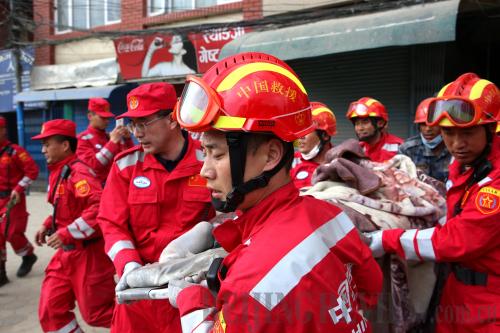 |
|
ONE AMONGST MANY: The China International Rescue Team recovers a local survivor from a collapsed building in Kathmandu on April 26 (BAI YANG) |
An 8.1-magnitude earthquake devastated Nepal on April 25. The earthquake was so powerful that it shifted the ground beneath Kathmandu, Nepal's capital, by as much as three meters to the south, according to the Nepalese authorities.
The world has now turned its eyes to the earthquake's aftermath, as images broadcast from Nepal shook the international community. The death toll in Nepal has surpassed 5,000 and is still climbing as authorities and law enforcement rush to confirm local people's whereabouts.
Nepal's Prime Minister Sushil Koirala projected that the death toll may well reach over 10,000.
The earthquake, which also affected neighboring areas of southwest China's Tibet Autonomous Region, may not even be over, as survivors await possible strong aftershocks that often follow the initial quake.
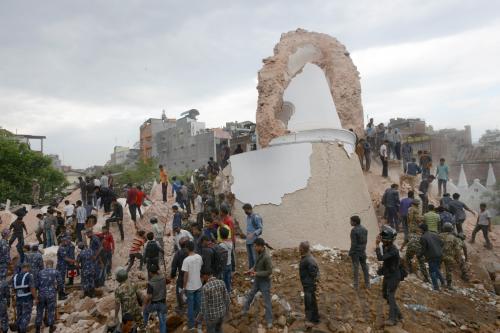 |
|
STILL STANDING: Nepalese rescue members gather at the collapsed Darahara Tower in Kathmandu on April 25 (XINHUA/AFP) |
Fearing for our own
Famous for its scenery at the Himalayas and its rich cultural heritage, Nepal attracts over half a million tourists all over the world every year. Tourists enjoy hiking and mountain climbing. Chinese and Indian citizens together account for 36 percent of foreign tourists in Nepal, according to the country's tourism authorities. Thanks to more air routes, increasing numbers of Chinese tourists have chosen Nepal as a tourist destination in recent years.
Of those Chinese tourists, 6,000 were in Nepal when the earthquake took place. Li Qiong, a 25-year-old tour guide, was in a town near Kathmandu. She immediately assembled all 21 of her group members, and fortunately, no one was injured.
The group had traveled from north China's Shanxi Province to Nepal for a 10-day trip. Over the past five years, Li had often accompanied Chinese tourists to Nepal, but the sudden earthquake turned the relatively familiar terrain into a nightmare for her.
"Many old buildings that we had just visited and taken photos of in the morning collapsed within three minutes as earthquake shook in the afternoon," Li recalled.
The nightmare continued throughout the 30 minutes following the earthquake, during which aftershocks hit repeatedly.
"A local tour guide took us to the open ground of Durbar Square to avoid the dangers of the aftershocks," Li said.
 |
|
SOLIDARITY AMONG CHAOS: People clear rubble in Kathmandu's Durbar Square, a UNESCO World Heritage Site that was severely damaged by the earthquake on April 25 (XINHUA/AFP) |
However, for Li, the reality of the earthquake's destruction didn't begin to hit her until she processed the damage with her own eyes.
"I just couldn't believe that we were survivors of a devastating earthquake until we walked through the ruins of buildings," Li said.
The next day, Li's travel agency helped these tourists board an airliner which took them back to Lhasa in China.
On the way to the airport of Kathmandu, Li and her group members made donations to their local Nepalese tour guide and driver.
"We are grateful for everything they've risked," Li said. "They were with us the whole time after the quake. They did not go home for their families until their job was finished."
Li and her tour group's homecoming was emotional, to say the least.
"We all burst into tears when we arrived at Lhasa airport and saw the electric board which said 'welcome home.' We were moved because so many people cared about us, and our country did the best to bring us home," Li said.
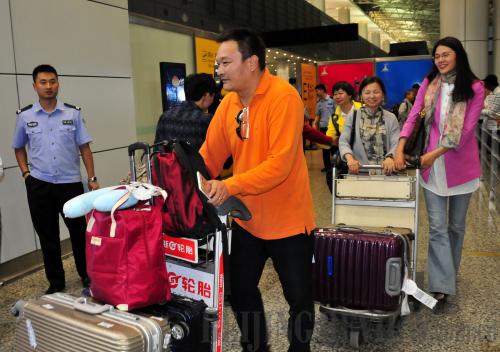 |
|
SAFE AND SOUND: A total of 100 Chinese and 15 foreign travelers on board a China Southern Airlines plane land in Guangzhou Baiyun airport on April 26 (HUANG GUOBAO) |
Foreign travelers flocked to Kathmandu's airport after the earthquake, and the airport struggled to accommodate its passengers in the wake of the damage. Many countries have performed similar efforts to evacuate their citizens.
Chinese embassy diplomats in Nepal got in touch with every Chinese citizen known to be in the quake-stricken region as soon as possible. Major Chinese airlines added planes to Kathmandu to evacuate Chinese citizens. As of April 27, Chinese airlines have taken 1,809 passengers back home, according to Guangzhou-based Southern Metropolis Daily in south China's Guangdong Province.
In addition to the devastation that swept Nepal, the quake also triggered deadly avalanches on Mount Qomolangma, known as Mount Everest in the West, swallowing nearly 20 foreign mountaineers including Daniel Fredinburg, a 33-year-old Google executive. Hundreds of people were trapped in the base camp on the mountainside. Mount Qomolangma's climate is already harsh, a situation only made worse by the earthquake.
Around 40 Chinese mountaineers making up four teams were on the south slope of Mount Qomolangma when the quake came. Mountaineering organizations have commissioned helicopters to rescue survivors stranded on Mount Qomolangma.
Li Zhixin, President of the Chinese Mountaineering Association (CMA), told Beijing-based Global Times that most mountaineers chose to climb the mountain in April and May because of the agreeable weather.
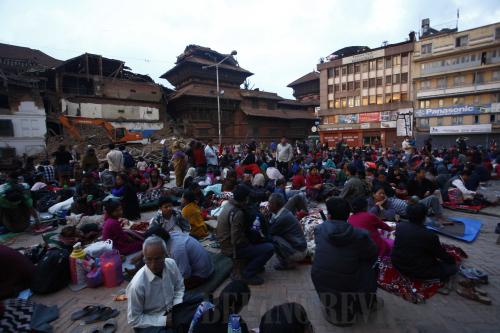 |
|
SEEKING HAVEN: Survivors gather at a square in Kathmandu and try to escape from aftershocks on April 26 (XINHUA) |
The CMA had warned that, if a natural disaster were to occur, the chances for survival for the large number of mountaineers camping on route to Mount Qomolangma would be slim, Li said.
There is little possibility for surviving an avalanche. In the face of nature, humans are simply too small, Li said.
International aid
While foreign citizens were evacuated, international rescuers and aid have been arriving in the country to help cope with the damage dealt by the worst earthquake to hit Nepal in over 80 years. The international community has joined with Nepalese forces to search for survivors under the rubble of collapsed buildings in quake-hit areas.
On April 26, the Chinese Government announced it would offer 20 million yuan ($3.22 million) in aid to Nepal. The Red Cross Society of China delivered the first 186 tons of emergency supplies to the earthquake-stricken country from Beijing on April 27.
In addition to supplies, China took quick action to send disaster relief forces to Nepal as well as disaster areas in China's Tibet, in the hope of saving as many as possible in the "golden 72 hours," after which the chance of finding earthquake survivors diminishes immensely.
China has been improving its disaster relief capacity and resources since a devastating earthquake, which took the lives of nearly 70,000, struck southwest China's Sichuan Province in 2008.
China International Rescue Team, consisting of 62 members and six trained hounds, arrived in Kathmandu on the morning of April 26. Taking advantage of their proximity to Nepal, they were the first international team in the country and immediately set to work upon their arrival. That afternoon, they successfully recovered a survivor.
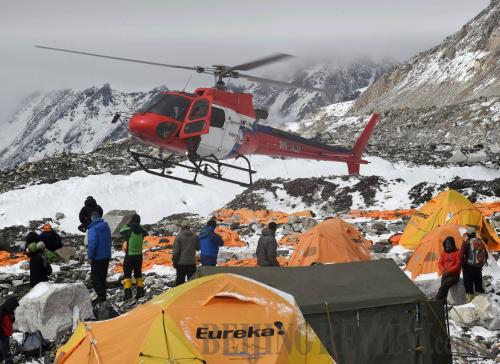 |
|
SIGHT OF HOPE: A rescue helicopter prepares to land and airlift the injured from Mount Qomolangma South Base Camp in Nepal on April 26, a day after an avalanche triggered by the 8.1-magnitude earthquake devastated the camp (XINHUA/AFP) |
Meanwhile, four IL-76 aircraft of Chinese Air Force were sent to carry humanitarian aid and a 58-person medical team to Nepal, announced Shen Jinke, spokesman for the Chinese Air Force in Beijing.
Zhou Shengping, Xinhua News Agency's correspondent in Kathmandu, said that Nepal's rescue mission faced many difficulties.
Nepal's rescue forces were overworked in the days following the quake. Tired and struggling to find effective tools, they continued to search, as the country's need was too great for them to rest.
The lack of aircraft slows down rescue missions in Nepal, because many roads leading to disaster-hit mountainous areas were destroyed by the quake and subsequent landslide.
The Chinese Academy of Sciences has opened its high-resolution satellite graphics of Nepal's quake-hit areas in a bid to streamline rescue work and avoid casualties from possible future disasters, including landslides and glacier collapses.
In the meantime, the international community has also extended a hand to Nepal. India, another neighboring country of Nepal, offered several aircraft carrying medical supplies and a mobile hospital, as well as a disaster response team. The United States delivered a disaster response team and an initial $1 million in aid. Pakistan sent four C-130 aircraft carrying a rescue team and medical doctors as well as disaster relief supplies to Nepal.
Despite the timely aid from other countries and rescue efforts, one thing is clear: Aid for the broken hearts of Nepal can't come fast enough, and it will take a long time to even begin to recover from the devastation that has rocked the country.
Copyedited by Kylee McIntyre
Comments to baishi@bjreview.com | 